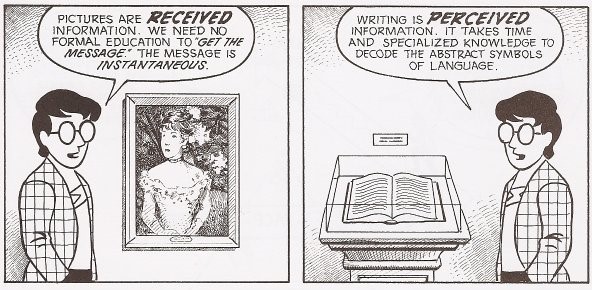“Participation is a powerful force in any medium.” -Scott McCloud
In linear models of communication, like the one pictured below, the speaker functions as a sender, and the audience members function as receivers.

But we know this isn’t the most accurate or complete picture of how communication actually works. When an audience member laughs, nods in agreement, or yawns in boredom, the receiver has become the sender. And vice versa. Great presenters know how to free the audience from their singular role of receiving. They invite participation. They create an active audience.
Comics is a genre that relies heavily on audience participation to help fill in the blanks and move the story forward in space and time. This week we are looking at the similarities between the verbal-visual arts of comics and public speaking. Our guide is Scott McCloud’s book, Understanding Comics: The Invisible Art. Today, we’ll look at two concepts that deal with audience participation: identification and effort.
Identification
The principle of identification is an important one in many fields from psychology to communication. Theorists like Freud, Wollheim, and Bettelheim have studied it extensively. Bettelheim says that identification involves recognizing another person’s perspective and internalizing his worldview. It’s the ability to realize that every “you” that we encounter is an “I” from another viewpoint.
Identification allows us to seek connection and better communication. It’s the pathway to trust and deeper understanding. It’s what links the senders and the receivers. And it’s not always easy. Audience members might love a speaker who is funny or confident, but that’s only part of the equation. McCloud reminds us that “we humans are a self-centered race.”

If McCloud is right, and we (speakers and audience members alike) are making the world over in our images, that should greatly influence the way we structure and prepare our presentations. Why? Because we will always be talking with an audience who is primarily concerned with how the message benefits them. That means that the ability to be funny or confident won’t matter if we can’t connect our presentation with the audience’s needs, if we can’t see it through their eyes. This lesson reminds us how important audience analysis is. How does our presentation reflect, influence, and affect the people we are communicating with, not at, with?
Effort
The amount of energy it takes to process words versus pictures is quite different because they are different types of icons. Here’s how McCloud explains it.

The audience has to spend time deciphering and connecting the series of words being presented. Then they have to filter them through that self-absorbed lens we talked about above in order to create meaning. On the other hand, pictures require very little perception. They are received quite easily.
That means, when we have a presentation that uses both verbal and visual channels, we reduce the effort required by the audience. If we launch into a lengthy speech without any visual support, we are asking the audience to put in a lot of effort to perceive meaning. On the other hand, if we break up verbal reports with visuals, it gives the audience a break from the heavy processing that words require.
Comics remind us that the audience plays a huge part in the communicative process. As speakers, we have to be willing to identify with them, meet their needs, see through their eyes, and respect the effort they are putting in to listen and learn when we present.
Ethos3 exists to help our clients master the verbal-visual world of presenting. How can we help you today?